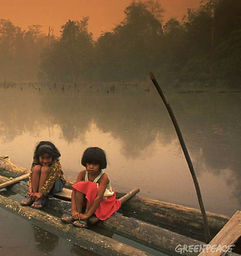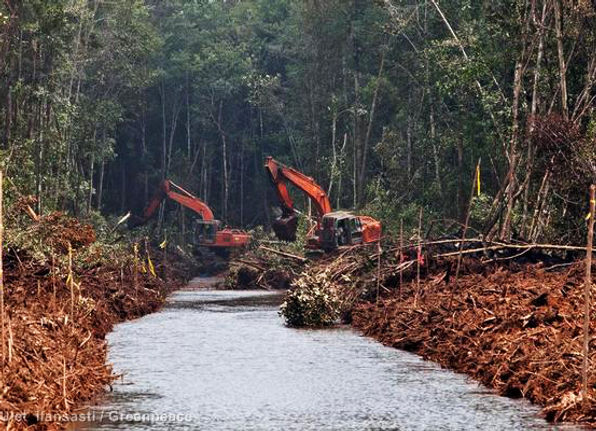Schuster Institute for Investigative Journalism
at Brandeis University
i n v e s t i g a t i o n s
































































Our investigation reveals that some palm oil--the most widely used vegetable oil in the world--is produced with slave labor. Palm oil is in all the products above, and many more.
Palm Oil Controversies
Photo | Rainforest Action Network
Photo Inset: Jean Kern
The Abuse:
Environmental Destruction
Pressure from environmentalists-led industry groups and environmental organizations to create the Roundtable on Sustainable Palm Oil (RSPO) in 2004 to address problems associated with the industry and to develop sustainable production methods.
In spite of efforts by the RSPO and after hearing complaints from civil society groups about the treatment of smallholder farmers and indigenous groups living near oil oil plantations, between 2009 and 2011, the World Bank paused its private sector investments in
palm oil.
This section explores the environmental and social concerns in the Southeast Asian palm oil industry, and how various sectors are documenting problems and trying to solve them.
The Environment
As demand for palm oil exploded worldwide over the past twenty years, so too has the need for land for oil palm plantations. A slow return on investment (oil palms don't reach peak productivity until three to five years after planting) combined with low land conversion costs and logging that yields profitable results makes logging a rainforest area and then burning to clear the land a more attractive prospect for palm oil ventures than reusing old agricultural land. This aggressive process of transforming available rainforest to palm plantations, especially in Indonesia, has brought with it myriad environmental problems.
Deforestation
Numerous studies and reports by environmental organizations and the scientific community illustrate the severe loss of Indonesia's primary rainforests and its consequences.
Data from the World Bank shows that 65% of land in Indonesia in 1990 was forest land, while in 2006 this figure had shrunk to 48%. According to the United Nations’ Food and Agriculture Organization, Indonesia had the third largest annual net loss of forest area between 2000 and 2010.
Outcry from environmentalists and concern in Indonesia over the disappearing rainforest resulted in the government establishing a countrywide moratorium on deforestation of new land concessions in 2011, which, according to a Thomson Reuters news report, President Susilo Bambang Yudhoyono officially extended on May 13.
The Forest and Peat Land Moratorium, as it is now called, is a presidential instruction and not legislation, which proponents say will facilitate implementation. Critics say enforcement of the moratorium is weak and legislation would provide more tooth for law enforcement and prevention efforts.
Above, Sekonyer community members watch as an excavator tears down trees and digs a drainage canal in preparation for new oil palm plantations in one of the last areas of natural forest remaining in the buffer zone of the Tanjung Puting National Park.
"The Tanjung Puting [in Central Kalimantan]," writes Ashley Schaeffer for the Rainforest Action Network, "is a globally recognized biosphere reserve and an unparalleled diversity hotspot. It’s home to many endangered species such as orangutans and Clouded leopards."
Inset photo: The rare Sumatran Orangutans are a critically endangered species which lives only on the Indonesian island of Sumatra.
Old Smartphones
Will Record Chainsaws in Rainforests in Indonesia

Photo | E. Benjamin Skinner

A new project by Rainforest Connection will put old Android Smartphones to work listening for sounds of chainsaws and illegal logging in the rainforests of Indonesia. According to the World Wildlife Foundation, 73% of all timber production in the country is believed to be sourced through illegal logging. The Jakarta Post reports the government has plans to ban the auction of seized illegal timber as a way to curb illegal logging.

Photo | Sekala, World Resources Institute
Project POTICO is a project by the World Resources Institute that has identified low carbon degraded land in West Kalimantan for conversion to palm oil plantations as an alternative to destroying rainforest habitats.
Photo | Global Fire Monitoring Center published at nasa.gov
Above, blazes that raged in 1997 in Indonesia. Burning was used to clear forests for agricultural production but an unusual El Niño drought that year resulted in huge forest and peat fires that not only devastated habitats but degraded air quality for inhabitants far and wide.
Palm trees near PT 198 in East Kalimantan (Borneo). After 30 months palm trees will start generating fruit that can be harvested, will reach peak productivity after five years, and typically, will decrease in productivity after 20 to 30 years. Indonesia’s palm industry is much younger than Malaysia’s, and so many of its trees have yet to reach their peak. Most oil palm plantations in Indonesia are on the islands of Sumatra and Kalimantan. In Malaysia, Sabah and Sarawak (also on the island of Borneo/Kalimantan) are the highest palm producing states.
CO2 emissions increased from 95M metric tons in 1980 to 330M metric tons in 2006.
World Bank data from "Indonesia: A Vulnerable Country in the Face of Climate Change" by Mariah Measey.
China and the US produce 37% of world GHG emissions.
UNEP Emissions Gap Report 2012.
In a recent announcement,
China pledged to impose
carbon reduction targets for 2016.
Experts warn the US is not on track to meet its pledge to reduce US GHG emissions to 17% below 2005 levels.


Photo | NASA, Creative Commons, Wikipedia
Sumatran Orangutan. Photo | Jean Kern
Sumatran Elephant. Photo | David Gilbert
Further Reading
"Palming off a National Park: Tracking Illegal Palm Oil Fruit in Riau, Sumatra," World Wildlife Fund, July 2013.
“Truth and Consequences: Palm Oil Plantations Push Unique Orangutan Populations to Brink of Extinction,” Rainforest Action Network.
“Oil palm plantations: threats and opportunities for tropical ecosystems,” United Nations Environment Programme Global Environmental Alert Service, December 2011.
An underweight adult male orangutan is tranquillized by officers from the Sumatran Orangutan Conservation Programme before being captured and relocated in Tripa forest of Aceh province in Sumatra. Tripa is home to the largest remaining population of endangered Sumatran orangutans. More photos at the Guardian.
Photo | Paul Hilton/SOCP/YEL
Sumatran Tiger. Photo | Wikipedia Commons
“The Last Stand of the Orangutan,” United Nations Environment Programme, February 2007
“Seeds of Destruction: Expansion of Industrial Oil Palm in the Congo Basin: Potential Impacts on Forests and People,” Rainforest Foundation UK, February 2013
“Testing the Law: Carbon, Crime and Impunity in Indonesia’s Plantation Sector,” Telapak and Environmental Investigation Agency, July 2012
“Clear-Cut Exploitation: How International Investors & REDD+ Donors Profit from Deforestation in West Papua,” Telapak and Environmental Investigation Agency, May 2012
Selected Film Documentaries
Two documentaries (trailers above) by Journeyman Pictures document the palm oil industry. "Lost in Palm Oil," 2007, and "Greasy Loot," 2002 are available at their website for a small viewing fee. Transcripts are also available there.
Next: Local Economies
On this page
Environmental destruction:
Deforestation
Carbon emissions
Wildlife endangerment
& loss of plant diversity
Further reading
FILM: "Lost in Palm" & "Greasy
Loot" by Journeyman Pictures
Links to other sections
1. Forced Labor on
Palm Oil Plantations
2. From Palm Fruit
to Product
3. Human Rights Abuses & Other Controversies
1 | Forced labor & child labor
2 | Indigenous peoples' rights
3 | The environment <
4. Palm Oil Industry Response

Photo | E. Benjamin Skinner
Old Forest Destruction. Above, old growth forest in East Kalimantan is destroyed in order to plant new palm trees. On the entire island of Kalimantan, more than 3 million hectares of forest were lost between 2001 and 2010, according to analysis by the World Resources Institute (WRI). A new Forest Cover Analyzer web tool by WRI focuses specifically on forests in Kalimantan.
Photo | Greenpeace
Old forest clearance in Kalimantan (Borneo). According to the United Nations’ Food and Agriculture Organization, Indonesia had the third largest annual net loss of forest area between 2000-2010. More than 50% of the primary forests on two provinces on the island of Sumatra have been destroyed since 1990. On both the islands of Sumatra and Kalimantan, between 2000 and 2008, remote sensing detected the loss of 5.4 million hectares of forest. In Kalimantan, 90% of palm oil plantations were converted from rainforest. Cited as among the reasons for rampant deforestation for oil palm cultivation is disregard of the land rights of indigenous peoples.
Carbon Emissions
The race to clear land for cultivation, especially the burning of natural peat lands, contributes to Indonesia’s role as a significant emitter of greenhouse gases (GHG) worldwide. Many of the thousands of hectares of forest that have been burned to create palm plantations in Indonesia are on peat lands (73%; 26% in Malaysia), which, when destroyed and exposed, release massive amounts of carbon dioxide.
Exacerbating the problem, the carbon-rich peat becomes exposed and dry without a protective forest cover, making it especially prone to sparking out-of-control wildfires across cleared ground and releasing a great deal more carbon dioxide into the atmosphere. In 1997, massive peat fires in Indonesia were responsible for 13 to 40% of the world’s carbon dioxide emissions for the year.
Global warming and changing weather patterns go hand-in-hand with greenhouse gas emissions, and Indonesia, especially the poor population, is considered at risk for bearing the brunt of that impact. (For more read "Indonesia: A Vulnerable Country in the Face of Climate Change" by Mariah Measey published in Global Majority E-Journal, Vol. 1, No. 1 (June 2010). Charts below are sourced from this document.)
Left, pollution over Indonesia, 1997; right, peat fires in Tripa, 2012. Above left, using NASA's Earth Probe Total Ozone Mapping Spectrometer (TOMS) satellite instrument, researchers captured imagery of smoke and smog over the Indian Ocean on October 22, 1997 during the massive peat fires in Indonesia that year. The fires, some of which were set to clear land for cultivation, damaged as many as nine million hectares of land and released unprecedented amounts of soot, carbon dioxide, and other gases into the atmosphere. The smog that resulted spread over much of Southeast Asia, creating a giant cloud of pollution.
Above right, peat fires over Tripa forest in Sumatra in 2012 outrage environmentalists who call for better enforcement of the logging moratorium which is intended to protect the forests and peat swamps.
Wildlife Endangerment & Loss of Plant Diversity
Researchers estimate that without dramatic changes to forestry policies in Indonesia, the country could lose 75% of its original forests and 42% of its biodiversity by 2100. The aggressive deforestation practices on Sumatra have led to loss of habitat and caused the rare Sumatran orangutans, native only to the island, to become critically endangered. The orangutan population living in and around the Tripa forest where most of them dwell has declined to a mere 20% of its original total in the past decades.
The International Union for Conservation of Nature (IUCN) lists 244 native animals and plants on their endangered list and 722 that are vulnerable.
Below, the Sumatran Orangutan, humans' closest living relative in nature with 97% shared DNA, is critically endangered, as is the Sumatran rhinoceros, the Sumatran tiger, and the Sunda otter civet, which is endangered, and many other breeding birds and plants. Learn more about endangered flora and fauna at the IUCN's Red List of Threatened Species database.
Most CO2 emissions in Indonesia are connected to deforestation.
World Bank data from "Indonesia: A Vulnerable Country in the Face of Climate Change" by Mariah Measey.
At a June visit to the Greenpeace ship Rainbow Warrior III, President Susilo Bambang Yudhoyono thanked Greenpeace for its environmental activism and asked for its continued partnership in helping Indonesia meet its environmental goals set in 2009 to reduce carbon emissions and curb deforestation, which he says it is on target to meet.
Indonesia Says It is On Target to Reduce GHG Emissions by 26% by 2020
Sumatran Rhinoceros. Photo | Wikipedia Commons
Photo | Sumatran Orangutan Conservation Program published at mongabay.com













